After-Hours Tour of the Fraunces Tavern Museum: "Path to Liberty"
Explore a new exhibit inside the oldest building in Manhattan, a witness to history throughout the Revolutionary War Era!


Image via Library of Congress
Today, Coney Island is home to attractions like the famous Cyclone roller coaster, the Wonder Wheel, some haunted trains, bumper cars, and several kiddie rides. However, if you were to walk around Coney Island over a century ago, you’d notice some bizarre attractions that you might find hard to believe even exist. While all of the attractions on this list are a bit odd, a few wouldn’t even be acceptable today. From its “midget villages” to questionably safe rides and outlandish sideshows, here are some of the strangest attractions in Coney Island’s history, reflecting differences in New York City’s cultural values and technological abilities compared to today.
Also called “Midget City,” Coney Island’s Lilliputian Village had three-hundred dwarves and little people living inside, and even contained small-scaled furniture, houses and vehicles. How did these small inhabitants come to live here? Samuel Gumpertz, who managed Dreamland, traveled around the country and even to areas outside of it looking for small people to live in Midget City. Most inhabitants came from different World’s Fairs, circuses and freak shows, and the attraction opened in 1904. Here, villagers would perform in circuses, theater and operas, and also had their own fire and police departments, as well as a beach with mini-lifeguards. The village would also occasionally have “giants” strolling around.
Located in the indoor amusement enclosure called the “Pavilion of Fun,” the Human Pool Table featured spinning discs for riders to navigate between. The goal of the attraction was for riders come out of an initial chute and move from one side of the attraction to the other on the discs, without being “seriously diverted.”
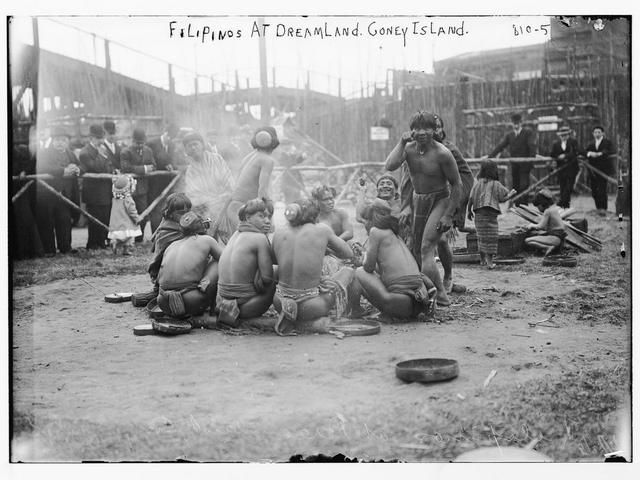
Image from Library of Congress
The Igorrotes were a tribe from a region north of the Philippines called Bontoc, and in 1905, showman Truman Hunt decided to travel all the way there and transport fifty Igorrotes to Coney Island. There, he paid them to showcase their native practices, in exaggeration, within the “Igorrote Village.” Luna Park advertised these sideshow performers as “head hunting, dog eating savages,” and had them eat real dogs in front of horrified audiences.
In the The Blowhole Theater, people were essentially forced to perform. The theater contained hidden jets of compressed air, which would shoot up through vents and blow up the skirts of exiting females. In addition, a clown and midget would electric-shock males with prongs. People would pay to watch the embarrassment from near the exit.
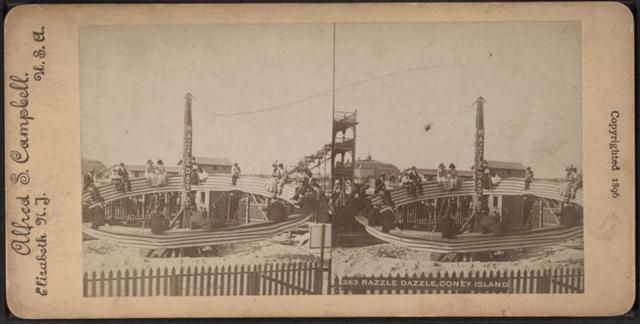
Razzle Dazzle in 1896. Image via New York Public Library
Also called the “Hoop-la,” the Razzle Dazzle was a circular swing fit for seventy people that Coney Island workers would push like a see-saw. Also located in the Pavilion of Fun, it was so dizzying that, according to The Sketch: A Journal of Art and Actuality, even the toughest of sailors would get sick on this ride.
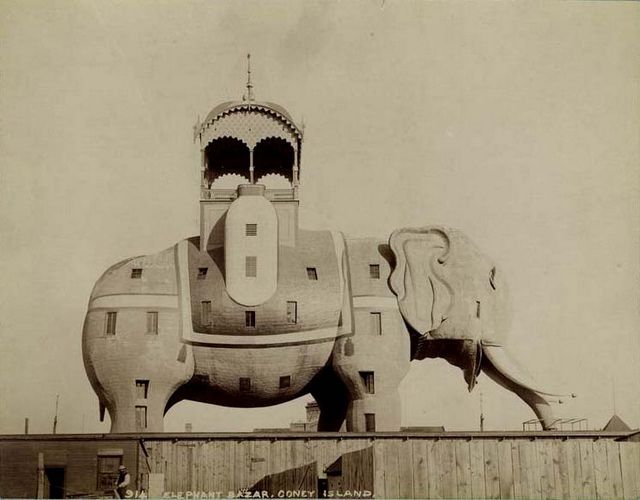
Image via Wikimedia Commons
From 1885 until 1896, Coney Island had the most fantastical of hotels: the Elephant Hotel (also called the “Elephantine Colossus” or “Elephant Colossus”). It was 200-feet tall with a gilded crescent and stood proudly and prominently on Surf Avenue and West 12th street. James Lafferty designed the 12-story building with 31 rooms, even calling it the “Eighth Wonder of the World.”
Inside the elephant was a concert hall, events bazaar, museum, observatory, cigar store, and diorama. Its legs were spiral staircases leading to higher rooms and its eyes were telescopes. However, “tourists got tired of the gimmick, and prostitutes started moving in.” Thus, according to the New York Historical Society, it then became more of an Elephant Brothel. But even the prostitutes began to get tired of it, so the Elephant Colossus was pretty empty by the time a fire destroyed it in 1896.
On this fantastical attraction, riders would fly to the moon in a large ship with flapping wings, called “Luna.” Held down by cables, passengers would feel the ship rise into the air and see European scenery and blinking lights below them, and eventually Earth decreasing in size to create the illusion of flying into space. After braving a storm, the ship reached the moon and passengers landed in the crater of an extinct volcano and were greeted by moon maids and miniature, singing moon men called “Selenites.” This wildly successful simulation became Luna Park’s signature attraction.
In addition to fun, Coney Island was known for literally bringing couples closer together and creating physical intimacy between men and women. One attraction that demonstrated this was the Barrel of Love, which was a large, revolving, wooden, barrel that forced men and women to tumble into and cling onto each other.
Noah’s Ark, a rocking funhouse located adjacent to the Boardwalk, was fit for families with young children. The inside contained a menagerie of animals that Noah saved from the Flood in the Bible, a mirror maze, moving floors, and more compressed air jets that blew up women’s skirts. Here, “Noah” would also give gifts to the children.
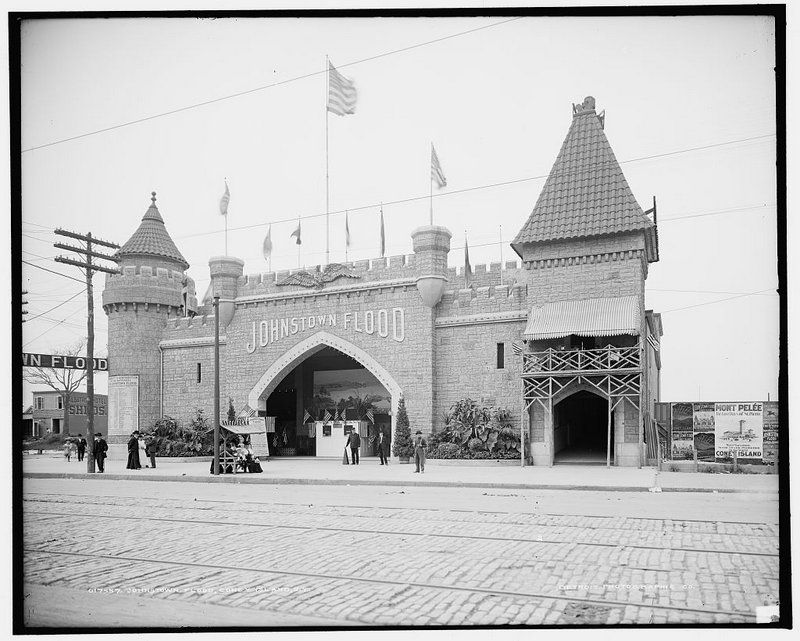
Photo from Library of Congress
Coney Island also showed simulations of real tragic disasters for audiences to watch. One popular reenactment was the 1902 Galveston Flood in a large building on Surf Avenue and 17th street. Workers used real and fake water, large amounts of cotton, and lighting and mechanical effects to simulate the real flood, which killed about 6,000 people in 1900. Other natural disaster reenactments were those of the San Francisco Earthquake, the Johnstown Flood, and the eruption of Mount Pelee.
Since horse racing was all the rage, George Tilyou built a mechanical horse-racing track for Coney Island visitors. According to PBS, this attraction featured six double-saddled mechanical horses that brought riders down 1,100 feet of track and across a stream and some hurdles. The tracks ran alongside each other to mimic a horse race in which heavier riders had an advantage. Workers for this ride dressed like jockeys and commenced each race with a bugle.
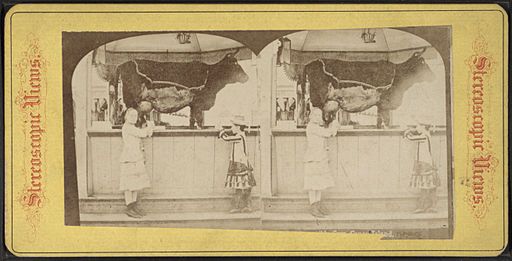
Image via Wikimedia Commons from New York Public Library
To use this strange mechanical wooden cow at Culver Plaza, visitors had to pay a nickel in order to get a glass of milk dispensed from the cow. Dressed-up dairy maids would serve the glass to them.
Passengers sat (or tried to) on this spinning wheel until it crazily flung them over to the ride’s outskirts. You can see what this dizzying ride was like in the above video.
This weird, five-cent show featured a young woman adorned in bridal attire. When she walked behind a screen, she and her groom became skeletons who were then served a feast.

Image via Library of Congress
Dr. Martin Couney’s Infant Incubator Exhibit opened in 1903 at Dreamland, during a time when few scientifically accepted the idea of infant incubators. The exhibit looked like your typical hospital ward with babies, nurses and doctors. One side of this ward was glass, and visitors would pay to walk through and look at the babies, some of which were placed in incubators in a hallway protected by a railing. A sign reading “All the World Loves a Baby” advertised the exhibit.
However, this exhibit was more than just a sideshow; it actually saved real lives, as parents would bring their premature infants to the incubators. Sadly, six babies from this exhibit perished in one of Coney Island’s raging fires. The exhibit closed in 1941, once people got used to the reality of incubators. This exhibit actually contributed to this acceptance and the advancement of medicine for premature infants.
Next, read about 27 Secrets of NYC’s Coney Island, the Coney Island Brewing Company and a personal Coney Island memoir. Get in touch with the author @sgeier97
Subscribe to our newsletter